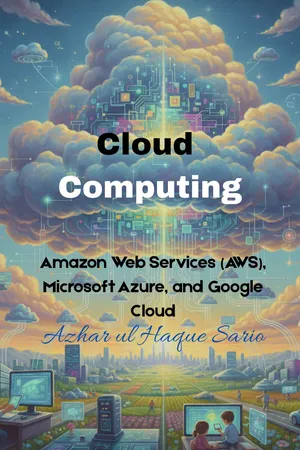
Cloud Computing
Amazon Web Services (AWS), Microsoft Azure, and Google Cloud
- English
- ePUB (mobile friendly)
- Available on iOS & Android
About this book
Dive into the World of Cloud Computing with This Comprehensive Guide!
This book explores cloud computing basics. It starts with foundational principles. You'll learn about distributed systems. It covers datacenter design and virtualization. The text explains the NIST framework. It details service models like IaaS, PaaS, and SaaS. Deployment options include public, private, and hybrid clouds. Chapters dive into AWS, Azure, and Google Cloud origins. Real-world case studies feature Netflix on AWS. Job skills sections prepare you for roles like cloud architect. It discusses hyperscale datacenters. You'll compare global infrastructures of the big three. The book analyzes hypervisors: Type 1 vs. Type 2. Containerization contrasts with VMs. Multi-cloud strategies are examined. Distributed systems principles include CAP Theorem. Consistency models range from strong to eventual. Consensus algorithms like Paxos and Raft are covered. Communication models discuss RPC and messaging. Core IaaS compute services are detailed. VM instance types and families are compared. Auto-scaling and load balancing are explained. Pricing models focus on cost optimization. Storage services include object, block, and file types. Networking covers VPCs, subnets, and security groups. Databases span relational, NoSQL, and NewSQL. Migration tools are highlighted. Container orchestration with Kubernetes is included. Serverless computing features Lambda, Functions, and Cloud Run. Data analytics tools like EMR, HDInsight, and DataProc are compared. Machine learning platforms such as SageMaker, Azure ML, and Vertex AI are analyzed. Security topics include shared responsibility and IAM. Governance, compliance, and FinOps are addressed. Future trends in cloud tech wrap it up.
What sets this book apart is its blend of academic depth and 2025 real-time applications, something many other guides skim over. Unlike generic overviews that ignore provider nuances, this one offers side-by-side comparisons of AWS, Azure, and GCP services, with hands-on labs and case studies like Capital One's multi-cloud approach. It bridges theory—like CAP Theorem—with practical job training, filling gaps in outdated texts that don't cover emerging trends like AIOps or confidential computing. Readers get competitive edges through skills like workload rightsizing and least-privilege IAM, plus FinOps strategies for cost savings—areas where competitors fall short by being too high-level or vendor-biased.
This author has no affiliation with the brands mentioned and this is independently produced under nominative fair use.
Frequently asked questions
- Essential is ideal for learners and professionals who enjoy exploring a wide range of subjects. Access the Essential Library with 800,000+ trusted titles and best-sellers across business, personal growth, and the humanities. Includes unlimited reading time and Standard Read Aloud voice.
- Complete: Perfect for advanced learners and researchers needing full, unrestricted access. Unlock 1.4M+ books across hundreds of subjects, including academic and specialized titles. The Complete Plan also includes advanced features like Premium Read Aloud and Research Assistant.
Please note we cannot support devices running on iOS 13 and Android 7 or earlier. Learn more about using the app.
Information
Table of contents
- Copyright
- Part 1: Foundational Principles and Core Technologies
- Part 2: Core Infrastructure as a Service (IaaS)
- Part 3: Application Platforms and Modern Architectures
- Part 4: Data Analytics and Artificial Intelligence
- Part 5: Cloud Operations, Security, and Governance
- Part 6: Advanced Architectures and Future Outlook